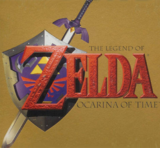Hey! Look! Listen! 3D! Look! Hey! Depth! Listen!
The update brings to the table a ridiculously keen sense of the original game, and I wouldn't be surprised if the game cart actually held a heavily modified image of the original Nintendo 64 version. Naturally the 3DS's PlayStation 2 level polygon capabilities, Xbox level texture abilities, and brand new shader quality don't go to waste, polishing up and tightening the graphics to the point where some entire swaths of land are completely unrecognizable to someone who doesn't have the original memorized. But the way in which the unmodified combat, puzzle structure and music all add up, it really does feel like a port rather than a remake. It's hard to say this is a bad thing, and it's helpful that it looks as good as we want to remember it does.
The game also shows off the best 3D effects the 3DS has to offer in its brief software launch desert. When the game is cranked up to the maximum 3D effect possible, the result is uncanny and unbelievably gorgeous. Environmental decorations float in and out of the handheld's screen freely while rooms have a distinct and genuinely useful sense of depth that, while gets taken for granted a few hours in, definitely gets missed once it's turned off. For those without a sense of depth or generally cranky charlatans, anti-aliasing is applied in 2D mode making the jagged edges of the slabbed polygons look substantially smoother. It's a nice consolation prize but it's a far cry from the childish wonder inspired by Kokiri Forest in 3D.
The game itself betrays its age only in a few areas, overall holding up fairly gracefully. Some of the puzzles are obtuse - worst of all the ones outside of the dungeons - and some of the game mechanics feel rote compared to later implementations in gaming history, but as a whole the game still feels worth playing and decidedly enjoyable. The combat, still executed by the Z Targeting mechanic, feels much smoother and responsive with the faster frame rate and better animations, even if it's not quite as good as later games in the Zelda series. Nobody expected even a game this good not to age at all, and considering its status and relative peers, it's actually quite impressive how much of the original experience is still intact.
The real jaw dropper is what holds up the very best: the game's scope. Once again, it's been beaten by more ambitious successors to its collection of thrones: games became more epic, more cinematic and more environmentally immersive than Ocarina of Time in only a matter of years after its release. But to see the firework that started many of these trends is sometimes more rewarding, especially when they're so deftly executed in such a early period of 3D graphics. Again the remake helps by polishing up the drawbacks of the original, particularly the blurry graphics and simple characters. By hiding a few of the aging elements it's easier to see just how big of an impact Ocarina was.
When it's all considered, Ocarina of Time 3D is a triumph - necessarily making the changes to the original that need to be made, but eschewing too much modern sentiment. It rejuvenates our memories of the Nintendo 64 classic by offering a genuine alternative to rose-tinted glasses and incorrect memories. We're allowed to enjoy the game without distraction and with just enough polish to put us right back in front of the television, more than a decade ago, when we first played what we now consider a defining game of the medium. Maybe it's not enough in the context of the 3DS' opening notes but in terms of remake execution Ocarina of Time 3D is one of legend, just like the game it emulates.

